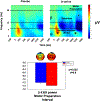Augmentation of learning in schizophrenia by d-serine and auditory remediation is related to auditory and frontally-generated biomarkers: A randomized, double-blind, placebo-controlled study
- PMID: 37690312
- PMCID: PMC11586877
- DOI: 10.1016/j.schres.2023.08.027
Augmentation of learning in schizophrenia by d-serine and auditory remediation is related to auditory and frontally-generated biomarkers: A randomized, double-blind, placebo-controlled study
Keywords: Auditory learning; Beta power; NMDA receptor; Oscillations; Schizophrenia; Target engagement.
Conflict of interest statement
Declaration of competing interest The authors report no relevant interests. Dr. Kantrowitz reports having received consulting payments within the last 24 months from Alphasights, Putnam, techspert.io, Health Monitor, Third Bridge, MEDACorp, Trinity, Globaldata, GKA, Clearview, Clarivate, Health Advances, ECRI Institute, ExpertConnect, Slingshot, Antheum, Guidepoint, First Thought, Wedbush, Jefferies, Otsuka, Vox Neuro and Reckner. He has served on the MedinCell Psychiatry, Merck, Leal and the Karuna Advisory Boards. He has conducted clinical research supported by the NIMH, Sunovion, Roche, Cerevance, Click, Neurocrine, Corcept, Taisho and Boehringer Ingelheim within the last 24 months. He owns a small number of shares of common stock from GSK. Dr. Iosifescu has received consulting honoraria from Alkermes, Allergan, Axsome, Biogen, Centers for Psychiatric Excellence, Jazz, Lundbeck, Otsuka, Precision Neuroscience, Sage, Sunovion; he has received research support (through his academic institutions) from Alkermes, Astra Zeneca, Brainsway, Litecure, Neosync, Otsuka, Roche, and Shire. Drs Sehatpour, Sobeih, Wall, and Mr. Govani, Shastry and Choo and Ms. Mayer and Govil reported no biomedical financial interests or potential conflicts of interest.
Figures


Update of
-
Augmentation of learning in schizophrenia by D-serine is related to auditory and frontally-generated biomarkers: A randomized, double-blind, placebo-controlled study.Res Sq [Preprint]. 2023 May 19:rs.3.rs-2943290. doi: 10.21203/rs.3.rs-2943290/v1. Res Sq. 2023. Update in: Schizophr Res. 2023 Oct;260:205-208. doi: 10.1016/j.schres.2023.08.027. PMID: 37293030 Free PMC article. Updated. Preprint.
References
-
- Fujimoto T, Okumura E, Takeuchi K, Kodabashi A, Tanaka H, Otsubo T, Nakamura K, Sekine M, Kamiya S, Higashi Y, Tsuji M, Shimooki S, Tamura T, 2012. Changes in event-related desynchronization and synchronization during the auditory oddball task in schizophrenia patients. Open Neuroimaging J. 6, 26–36. - PMC - PubMed
Publication types
MeSH terms
Substances
Associated data
Grants and funding
LinkOut - more resources
Full Text Sources
Medical

